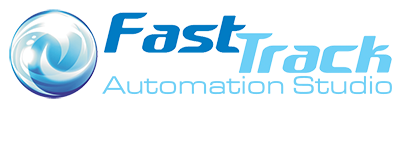The Ultimate Multi-Site Windows Server Login Script Solution
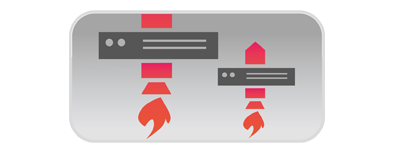
FastTrack Automation Studio can be used to take the complexity out of assigning network resources to users, whether they be on a single site / premise, multiple sites or remote users via VPN. Common tasks such as mapping network drives (from internal server and cloud drives) and assigning printers by either user or physical location – such tasks are easily automated using FastTrack.
Whether you are running few or many desktops, laptops and servers in your organisation, as an IT pro you will no doubt agree that Microsofts ‘one size fits all’ approach to logon script management – may meet some of the business requirements, but never all – simply because no two businesses are the same. The natural answer to this would be the writing of a number of batch files and login scripts, which over time end up becoming difficult to manage, complex, and potentially, insecure. FastTrack Automation Studios advanced command language enables you to vastly simplify login script operations, whilst at the same time, enabling you to add new powerful functionality, enabling you to perfectly match and typically exceed the requirements of the business.
There are too many functions for us to cover in detail, but let us walk you through the most significant – if you would rather watch a short video overview, click on the video below:
Login Script Builder GUI
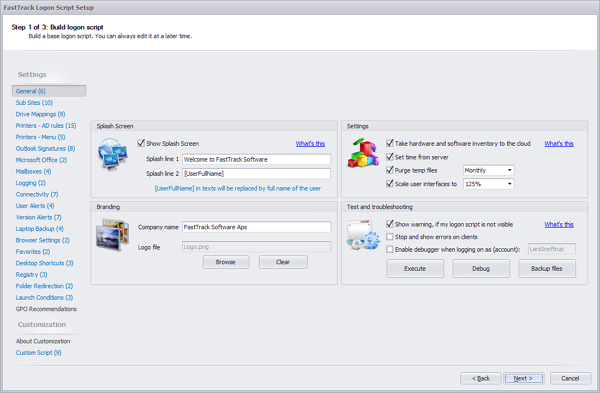
FastTrack studios Login Script builder GUI is where you can find the most commonly used features and function of FastTrack in an easy to use, highly organised GUI. One of the first and simplest operations is the addition of a company logo, which when added, all users will be greeted with when they log in. Being one of FastTrack’s features which is highly visible to users, you’ll find this simple addition to your network will be met with instant praise from management as it ‘professionally brands’ your login process!
Sites
As mentioned above, FastTrack’s ability to distribute scripts across sites can remove some of the biggest headaches facing todays more distributed IT environments.
Let's say you have 4 sites in your company and you know these by IP scopes. Then you can go two ways, either you simply merge everything into one script and use the IP scope condition - or you can use "Sub Sites" to create a logon script for each site based on IP scopes, meaning that on a specific site, the main script is executed plus this sites' "sub logon script". A sub site allows you to open the very same Logon Script Builder, but all settings will then only apply to the site you open. You can also mix; for example, shares could go on the main logon script and then printers could go on each sub site. As a rule of thumb, if you have complex printer mappings that you want to handle with FastTrack, sub sites is probably the way to go, especially if you use printer menus (see further down).
Drive Mappings
On the drive mappings page, you create a list of shares to connect. You simply create a full list of all possible shares for all users and then you set up a filter on each share, if required. You can filter on Active Directory groups and Organisations Unit of the executing computer or logged on user. You can also filter on IP scope. If your drive mappings are complex, you use the sub sites features to segment your list. Here’s an example below:
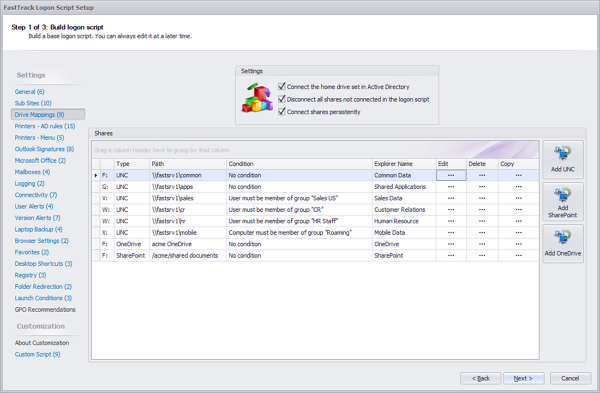
SharePoint and OneDrive
Notice in the above share mappings, there are two buttons named "Add SharePoint" and "Add OneDrive". The first button lets you add a SharePoint folder as a drive mapping. The way it works is that the user will be asked to log on to Office 365 as part of the logon process to establish credentials. If you use the OneDrive button, the user's OneDrive folder will be mapped to a drive letter. Note that this is OneDrive for Business and not OneDrive personal. If you have a fat OneDrive client installed on all computers, you should prefer this for performance reasons. The advantage of mapping to a drive letter is that you have central control over it and also, if you have clients that do not have the OneDrive fat client, this solves the problem. Note that under the Microsoft Office menu in the left, you can configure, if Office favours cloud storage (the fat client) or not. When mapping OneDrive to a drive letter, Office does not see it as cloud storage.
Printers
Printers you can connect in two ways. Either you can create a menu that the user will select a list of printers from, or you can use the same logic as with shares, where you filter printers on groups, OU or IP scope. The printer menu version is the most flexible way, because laptop users may roam around without logging on and off. And also, in many cases, a network is not broken down to such IP scope level that it's practically possible to identify suitable printers for everyone. With the menu version, you ask at first logon and you can create a desktop icon to show the choice of printers again. The selection will automatically be remembered and if you change printers on a location, changes will automatically be reflected, next time users log on.
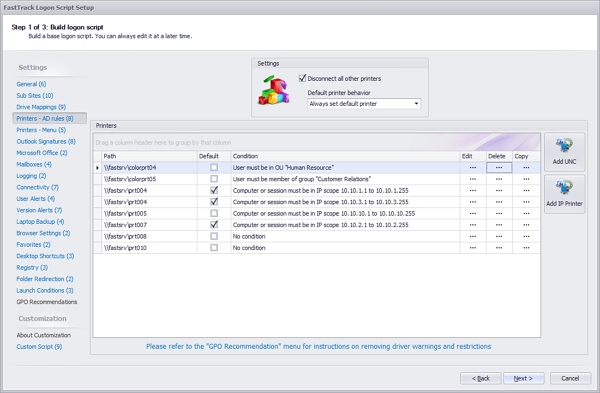
IP Printers
In the screenshot above, you can see that there are two buttons. One for print servers (UNC) and one for IP printers. Both printer menus and AD rules support IP printers as well as print server printers. It is just as easy to add an IP printer as it is with print server printers.
Connecting IP printers
Basically you just tell the host name or IP address of the printer and then you need to say, which print driver to use, just as you would have to on the server-side for print servers. If the printer driver is not a standard Windows driver, you need to put the driver files on a network share and point to it. To avoid typing the driver name wrong or point to a wrong path, it is highly recommended to use the "Browse" button shown above, because this will pop-up a pick list of driver names in the driver inf file and fill in all information automatically.
Office Settings
Under Microsoft Office in the menu, you can let the logon script set the Office user name to be the same as your Active Directory name and initials. This is typically a good idea to avoid users being creative, ending up with documents being stamp with names that are not recognisable. You can also overrule the default save paths for desktops and/or laptops. If you use Folder Redirection, this option is not necessary. You can also decide, if Microsoft Office applications default to saving to OneDrive or local disk.
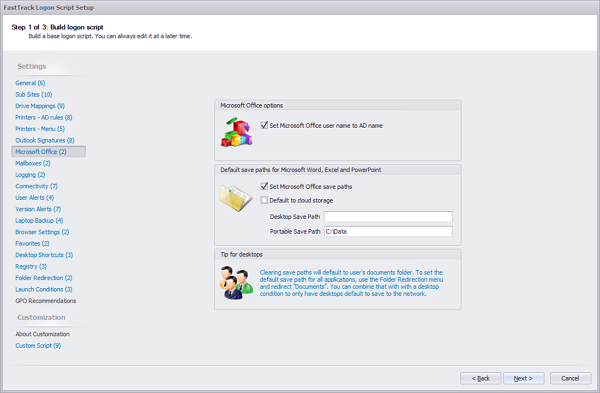
Centralised Logging
You can enable logging for user logons and errors at logon. This is a good idea to enable, as this gives you a great overview of what's going on, especially on errors. The reason logging is not enabled by default is that you need to provide a location on your network, where all users can write, as the logon script runs as the end user, who is typically not domain administrator. Once you have set up logging, you can use the two log sub-menus in the App Factory under "Logon Script". It is highly recommended to enable the error log, as this will allow you to proactively find potential problems
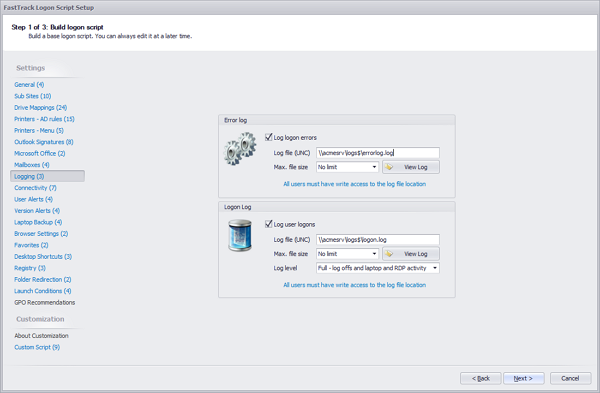
Connectivity
The connectivity menu allows you to run a background process to take some needed actions for the user to always have the correct drivers, printers and other settings, when connecting to VPN or resuming a Citrix / Remote Desktop sessions from a different computer. For Citrix/RDP sessions, the SmartConnect is used and for laptops, the SmartDock utility is used. Let us start with laptops. If you click the option to rerun the logon script on VPN connection, the SmartDock utility will be running in the background to detect the connection. This detection is not bound to any specific VPN software, it simply detects IP changes and executes the logon script, when it is possible. Similar, if you enable SmartConnect for Citrix/RDS session, if the user closes the session without logoff, the SmartConnect utility will run in the server-side user session and detect a reconnection. This way, when the user resumes a session, the logon script runs again and as the user may now be in another subnet physically, the user may need other printers. If the printer menu is used, the user will simply see the printer menu popup again to adjust the printers to the new client location. As a side-node, please observe the logging screenshot above. If you enable advanced logging, the SmartDock and SmartConnect utils will run regardless, if you enable them on this page or not, as these will be doing the actual logging other than the login.
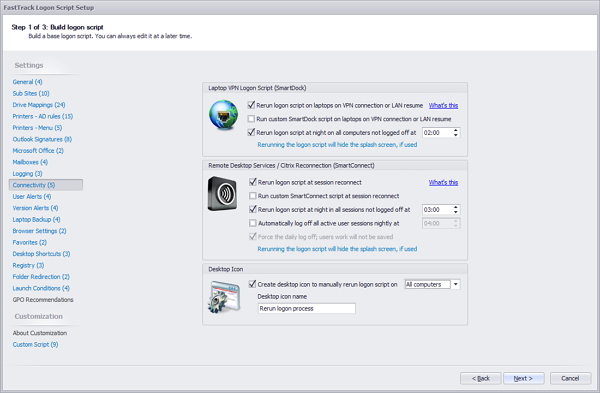
Password and low disk space alerts
Under "User Alerts", you can set up rules for expiry warnings and optionally show a codes of conduct screen. You can also set up a warning asking the user to clean up space or contact the IT department.
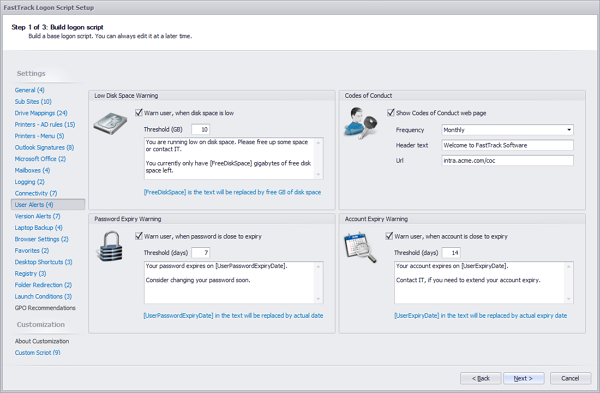
Testing for common software presence
Under "Version Alerts", you can define logging and/or alerts to users, based on installation status of Citrix Receiver, SCCM Client, Microsoft Office and the operating system itself:
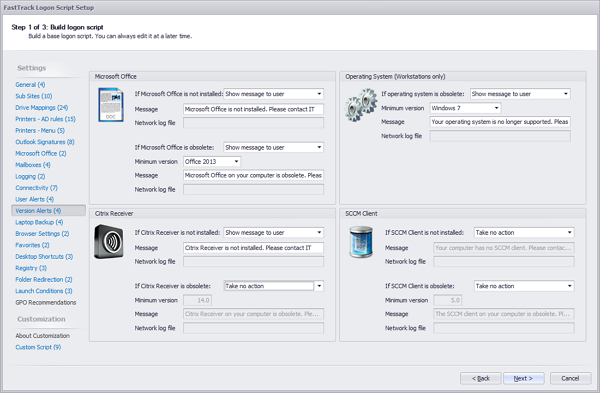
Laptop document and PST backup
Under the "Laptop Backup" page, you can set up a backup of documents and PST files for mobile users. Note that you can use any FastTrack function in the path, such as computer name and user's name. You can choose to take a backup at logon based on a frequency you decide, and/or you can place a desktop icon for the user to start the backup. FastTrack backups are based on the SyncDir command of the engine that is significantly faster than any other directory synchronizer, such as Microsoft's robocopy – so this functionality can be useful for many other applications, rather than just backing up documents & PSTs.
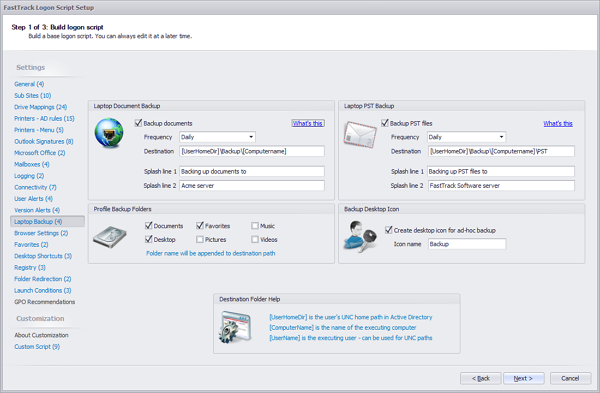
Browsers
The browsers page defines the start page of browsers and the standard browser, along with proxy settings:
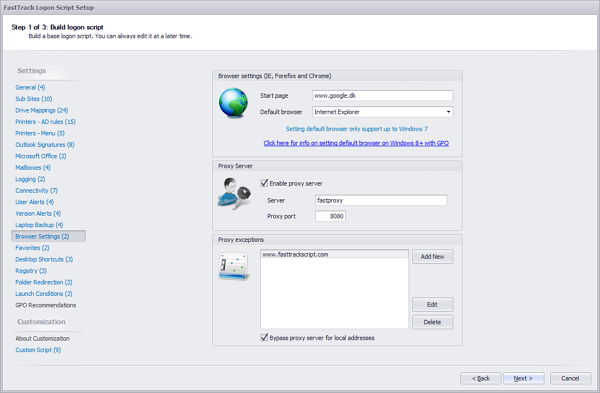
Launch Conditions
You can set up scenarios, where you do NOT want the logon script to execute. This could be relevant for virtual machines or remote sessions.
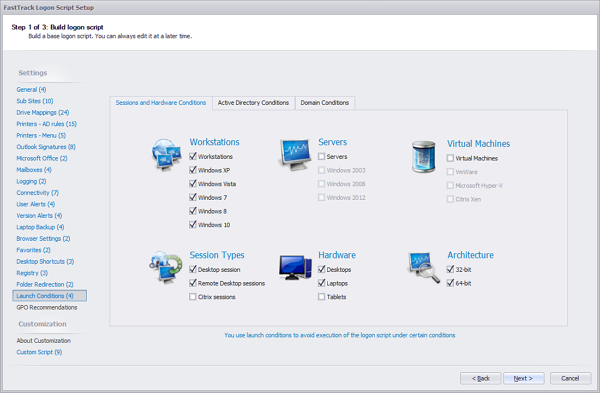
Additional Functionality
If you are wanting to manage desktop shortcuts, browser favourites, registry values and folder redirection, these functionalities are covered also – along with many, many more!
